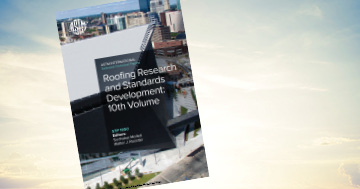
On Dec. 3, 2023, ASTM International’s Committee D08 on Roofing and Waterproofing held a technical symposium addressing roofing research and standards development. The symposium was the tenth in a series dating to the mid-1980s and provided insight into current research being conducted in the North American and European roofing industries.
The symposium consisted of presentations of 11 peer-reviewed research papers by 22 researchers. An overview of several of the presentations follows.
Some highlights
In “Advancing the Thermal Design of Commercial Roofs: Impact of Mean Operating Temperature, Thermal Bypass and Thermal Bridging,” researchers from the National Research Council Canada, Ottawa, Ontario, presented results from Phase II of NRCC’s Energy Rating of Commercial Roofs research.
Phase I results were presented at ASTM Committee D08 on Roofing and Waterproofing’s previous symposium held in December 2019. NRCA is a contributing supporter of NRCC’s ERCR research.
In ERCR Phase II, analysis highlighted the differences between using conventional design R-values for thermal roof insulation versus temperature-derived R-values. In the two examples presented, the latter method showed estimated losses from design R-values up to about 16%.
The Phase II research also analyzed the roles insulation board joints play in thermal losses in configurations of two-layer insulation above roof decks. The average losses in effective R-value ranged from 2% to 7% for ¼-of-an-inch-wide gaps and 4% to 9% for ½-of-an-inch-wide gaps in insulation layer thickness ranging from 2 inches to 9½ inches. The researchers indicated insulation board gaps can result from several factors, including manufacturing tolerances and board squareness, application variables and in-service board shrinkage.
Also analyzed was the role through-fasteners have on roof assembly thermal bridging. The study investigated three common fastener densities (four, six and 10 fasteners per 4- by 4-foot boards) and three R-value thicknesses (R-26, R-31 and R-36). The results show thermal losses ranging from about 5% up to 15% depending on the specific fastener density and insulation R-value.
The research also analyzed the thermal bridging of several types of penetrating rooftop-mounted photovoltaic mounts and found thermal losses up to 50% depending on the specific mount type and penetration frequency.
Symposium research paper titles
Evaluation of Moisture Accumulation in Composite Roof Decks in High Humidity Environments such as Natatoriums in Cold Climates Using Hygrothermal Modeling
Condensation in Cool Roofs—Code Changes, Field Observations and Hygrothermal Modeling
Advancing the Thermal Design of Commercial Roofs: Impact of Mean Operating Temperature, Thermal Bypass and Thermal Bridging
The Difficulties in Transitioning Control Layers from the Roof to Wall
The Need for Dedicated Air Barriers within Low-slope Roofing Assemblies
Compressive Deformation of Hot-applied Rubberized Asphalt Waterproofing
A Case Study of the Assessment of a Tensile Membrane Roof
Lessons from Roof Refurbishment Projects in the UL and Ireland
New Research on Hail Damage to 55% Al-Zn Alloy-coated Steel Roofing
Final Report: Does Underlayment Matter?
Performance of Aged Asphalt Shingles and Development of Climate-dependent Durability Index
The research concluded some roof assembly types will experience several thermal losses and the overall effect on the roof assembly’s thermal performance can be significant.
In “Compressive Deformation of Hot-applied Rubberized Asphalt Waterproofing,” researchers from Simpson, Gumpertz & Heger Inc., Waltham, Mass., analyzed in-service performance and laboratory testing of concentrated load compression in hot-applied rubberized asphalt waterproofing used in plaza decks, terraces and vegetative roofs. Examples of concentrated load compression include masonry veneer and precast concrete bearing points, wheel loads and undersized paver pedestals.
The research showed in-service examples of load compressions where hot-applied rubberized asphalt had compressed to negligible thicknesses, raising concerns whether the hot-applied rubberized asphalt would remain watertight.
Although no recognized test method exists for assessing hot-applied rubberized asphalt’s compressive resistance, the researchers developed an in-house laboratory assessment method that showed good correlation with various field conditions and the hot-applied rubberized asphalt types they observed.
The research also offered possible solutions to mitigate hot-applied rubberized asphalt’s compressive deformation. These include reducing or eliminating concentrated loads, increasing the areas of load-bearing surfaces, and supporting specific concentrated loads on elevated supports and possibly using a harder waterproofing material, such as PMMA (polymethyl methacrylate) to flash these elevated supports.
In “Performance of Aged Asphalt Shingles and Development of Climate-dependent Durability Index,” other researchers from NRCC discussed development of a climate-dependent durability index for assessing asphalt shingle roof systems.
The initial assessment is based on tear strength, fastener pull-through and tensile strength test methods specified as a part of physical requirements for products complying with CSA 123.5, “Asphalt Shingles Made from Glass Felt and Surfaced with Mineral Granules,” and ASTM D3462, “Standard Specification for Asphalt Shingles Made from Glass Felt and Surface with Mineral Granules.” However, though the test methods only provide for testing asphalt shingle products “as manufactured,” the researchers tested asphalt shingle products as purchased, after laboratory conditioning and after field-aging.
After aging, most of the evaluated properties no longer met the minimum requirements specified in CSA 123.5 and ASTM D3462. Some field-aged specimens showed a reduction in tear strength more than 50%.
Based on this limited data, a framework for a climate-dependent durability index is being developed and additional testing will be carried out.
Published proceedings
ASTM International has published the symposium’s proceedings as Selected Technical Papers 1650, “Roofing Research and Standards Development: 10th Volume.”
If you are interested in additional information about the research highlighted here or other research papers presented, I encourage you to purchase the symposium proceedings at astm.org.
MARK S. GRAHAM is NRCA’s vice president of technical services.
@MarkGrahamNRCA
COMMENTS
Be the first to comment. Please log in to leave a comment.